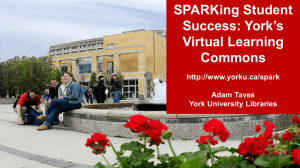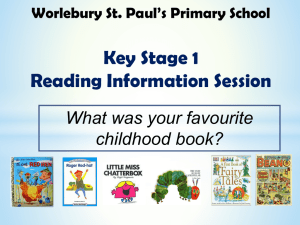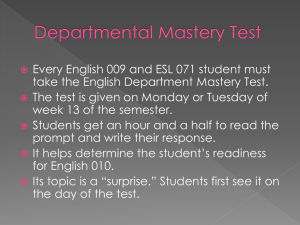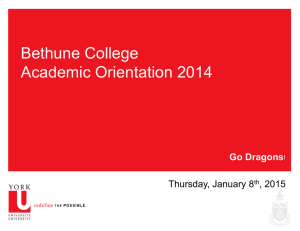Teaching First-year Students
advertisement
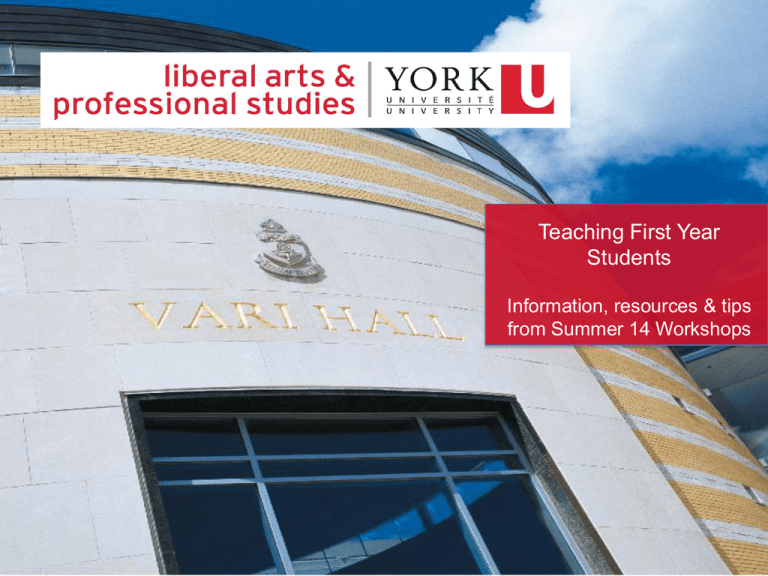
Teaching First Year Students Information, resources & tips from Summer 14 Workshops Teaching First Year Students ………………….. Information,resources and tips from Summer 2014 workshops facilitated by Celia Popovic and Diane Beelen Woody Focus is on 3 main areas • Who are our students at York and in LA&PS? Goal: to help faculty members be aware of the challenges facing students, and to promote teaching from a positon of empathy and understanding. • What is YU START and what is SPARK? Goal: to help faculty members be aware of two new initiatives: the YU START transition program and the SPARK library resources available to them and to their students. • How can we support first year students and build on the YU START foundation in the way we teach? Goal: to share tips and resources so that we provide the best possible first year experience as the first step to strong retention rates. Research shows that students set their behaviours for undergraduate study based on their first year experience. Introductions and Context This slide deck takes into account feedback from those who participated in the May, June or August workshop on Teaching at the 1000 level. • Who attended? -- faculty members from all three areas of LA&PS were represented, including full-time and contract colleagues, as well as TAs. • The majority of participants taught 1000 or 2000 level courses. • When asked to explain their biggest concerns about students in their courses, participants mentioned: - lack of preparation and lack of focus, - time pressures due to off-campus jobs and commuting, - lack of homogeneity in classes. Typical first year students • When asked, Which issues, in your view, affect their transition into university-level study? workshop participants highlighted the following: - lack of time to properly prepare classes and assignments; in many cases, this leads to academic dishonesty; - lack of focus, use of technology for social media rather than as a tool to enhance learning; - high levels of anxiety, lack of resilience and lack of awareness of supports available to them; - absenteeism from class and lack of attention to feedback on assignments and tests; - ESL needs that hinder participation in class and that affect the comprehensibility of their written work. • So who are our students? The next three slides provide some data from the Office of the Vice-Provost Students York University: Our Student Population (2012) Direct entry from high school from the Greater Toronto Area (GTA) Direct entry from high school from outside GTA 8.62% 15.59% Mature Students 55.24% 11.66% 3.3% International Students (101 and 105) Transfers from other Colleges 5.58% Transfers from other Universities Student Population in LAPS (2012) Direct Entry from High School from the Greater Toronto Area (GTA) 9.10% Direct Entry from High School from Outside the GTA 14.69% College Transfer (105) 47.51% 4.22% Mature (105) International (101 and 105) 20.42% 3.79% University Transfer (105) Student Segment Information (2012) • Three largest incoming cohorts of students into LAPS are i) direct entry (101) from the GTA, ii) college transfers and iii) international students • Majority of LAPS students are commuting and ESL is a significant consideration Student Segment % of Overall York Admits into LAPS LAPS Retained/ Graduated (Fall Admits – Nov. to Nov.) Commuting ESL Direct Entry (101) from the GTA 48.9% 81.8% 92.6% 32.3% Direct Entry (101) from outside the GTA 38.6% 79.6% 29.3% 16.9% College Transfer (105) 74.5% 76.4% 97.3% 31.5% Mature Learner (105) 59.2% 73.5% 96.8% 24.3% International (101 and 105) 70.8% 77.2% 71.7% 79.7% University Transfer 60% 80.9% 96% 21.4% Key characteristics of our students • Diversity is linked to all entry categories at York U: domestic and international, direct entry and transfer students. • And the previous slide shows us that the diversity is very pronounced in LA&PS : we have in our programs - 74% of the College Transfer students at York; - 59% of the mature learners at York; - 70.8% of the international students at York and - 60% of the transfer students from other universities. Key characteristics– continued • Living arrangements — notice the high percentage of students who are commuters (spending an average of 90-120 minutes daily); our lowest levels of commuters are the direct entry from outside the GTA and our international students. • First Generation PSE in Canada: approximately half of our students were not born in Canada; this includes a great many of our domestic entry, from the GTA. • Part-time learners who have off-campus jobs: this is the norm rather than the exception for our students. • Note the significant levels of students with ESL needs: - 32.3 % of our direct entry students - 24% of mature learners - 79% of international students. Impact on teaching and learning? Workshop participants highlighted the following: • Commuting and off-campus jobs contribute to many competing demands on students’ time, it is more important then ever to engage them in learning in the classroom, in the issues and concepts of the course, and to give clear starting points for readings and assignments. • Commuting and other responsibilities mean that many of our students will not be able to participate in the co-curricular activities York has to offer – for all such students, the classroom experience alone will determine if they engage and persevere with their studies. • Diversity can make group work even more challenging that it usually is. • First generation PSE students need feedback that shows clearly what they have done well and where to improve, with concrete suggestions. Otherwise they may see a low grade as confirmation that they so not belong and that they should abandon their studies . York’s welcome of incoming students -- a look at YU START and at SPARK • 1) What is YU START? -- a transition program for students entering directly from high school, based on the Alf Lizzio model of student transition, that students need to become purposeful, resourceful, capable and connected and to discover academic culture. • 2) What is SPARK ? -- the Student Papers and Academic Research Kit, on the York Libraries site, to guide students in understanding assigments, doing research and preparing papers in their courses. YU START: based on the Alf Lizzio model of transition – 5 senses Purpose Connectedness Capability Resourcefulness Academic culture Purpose • Students with a clear sense of purpose are not only more likely to find their study rewarding, but also to be more committed and persistent when the work gets challenging. • Students’ sense of purpose depends on their sense of vocation, their engagement with their discipline of study and their capacity to set personal goals. Resourcefulness • Successful students not only know how to study but also how to proactively manage the challenges of their whole university experience. • Students’ sense of resourcefulness depends on their ability to navigate the university system to get the help and information they need, willingness to speak up if they have a problem and an ability to balance their work, life and study commitments. Academic Culture • Successful students know the value of learning “how things are done” and what is important or valued in a new culture. • Students’ sense of cultural competence depends on their appreciation of the core values and ethical principles of the university and how these will inform their approaches to study and working relationships with fellow staff and students. Capability • Students who are better prepared for the roles and tasks of university study (i.e. “learning ready”) tend to have greater early academic success and are consequently more satisfied and more persistent with their studies. • Students’ sense of capability depends on how well they understand what is expected of them I the student role, their mastery of basic academic skills and their level of commitment to contributing to the academic community. Connectedness • Students with stronger connections are more likely to be successful learners, effective colleagues and happier people. • Students’ sense of connectedness depends on the quality of relationships with peers, with staff and their feelings of identification or affiliation with their School or University. Where to learn more about YU Start? • http://aifprojects.yorku.ca/student-experience/ (an overview of YU START) • Ongoing website with information, open to all : http://yustart.info.yorku.ca/ • Who is in YU START? In Fall 2014, all LA&PS students entering York directly from high school (Ontario, out-ofprovince, and international). All others (transfer students etc) were not included in the 2014 scale-up of YU START, but it is hoped that the 2015 scale-up will include them. • N.B. In Fall 2014, we have both YU START and non-YU START students in our courses. Instructors can assume that the majority, of students, but not all, have entered under the YU START transition program. But it is important to remember that the students themselves will have participated with varying degrees of enthusiasm and assiduity. The framework of the five senses is a robust one ; be sure to call attention to it and to the resources available to students, but do so in a way that is inclusive of both YU START and non-YU START populations. 3 Parts of YU START 1. On line Enrolment (May/June, ongoing through the summer) (videos to present course codes, dates, navigating York’s website, components of chosen degree program, all delivered through Moodle) 2. Online Learning Communities (9 weeks in July/Aug) (in groups of 25 students by program, 9 modules : Welcome; York U and Me; Getting Involved; Investing in Your Future; Pathways to Academic Success; Empower Yourself; Travel Guide to York U; Becoming a York Citizen; Ready/set/go to Making Connections) 3. Making Connections (morning of Sept 2, 2014) students connect with one another, their program, their College, York University; instructors from all the academic units participated to meet with incoming students How to build YU START---- applying the framework in the classroom • The five “senses” (purpose, resourcefulness, academic culture, capability, connectedness) of the YU START framework can all inform our classroom teaching. • Let’s look at each in turn, starting with connectedness, right from Day 1, bearing in mind that isolation is one of the most frequent complaints of York students, especially the international students, but domestic students as well. “Making Connections” in the classroom, starting with Day 1 • Workshop participants were asked How can you get your class off to a good start? How can you engage with “Making Connections”? Collective brainstorming yielded many variants of a basic idea: use groupings to break down isolation. - in a small or smallish class have students meet in groups of 2-3, ask one another a few key questions and then introduce one another to the larger group; - in a large class, have them meet in groups of 4-6; ask them to collectively submit a 1-minute paper on the end of day 1 to summarize what they are most curious about in the course and what most concerns them in the course outline/topics/assessment; - try to come up with a variant that is related to your course , e.g. geographic origins in a geography course, or any mechanism to activate tacit knowledge and to subtly point to the relevance of the discipline. N.B. Remember that it is important to model the course format on the first day; if you want to students to participate, to debate and discuss in groups, it is crucial to introduce that on Day 1. Connections throughout the term… Other ideas: - maintain the small groups from Day 1, keeping the students in pairs or small groups to accomplish small pair/share activities thorough out the term; use one clicker per small group to encourage discussion and dialogue; - encourage students to be note-taking buddies to fill in gaps in one another’s notes, to send notes if illness prevents a student from coming to class; - encourage the formation of study groups; - with first year students, have low-stakes group work activities and be clear about what is expected. What about the sense of purpose? • On Day 1 take a few minutes to share your passion for the discipline, your area of research, why you think this is an important discipline – this is hard to do in a compelling way for novices to the discipline. • Link your discipline to important questions for understanding oneself, society and societies, civic engagement etc. Be explicit about how your course is relevant in the broad sense and make the learning outcomes for the course meaningful. • Link each module of your course to the overall course outline so that students as “novice learners” understand the purpose of the different modules and their place in the course, e.g. by providing a concept map of the course. • Be clear about the purpose of the assessment instruments in the course and how they link to the learning outcomes. Consider “scaffolding” of assignments. What is SPARK? and how can it support the senses of resourcefulness, capability and academic culture? http://www.yorku.ca/spark/ How is SPARK organized? Instructors will want to spend some time exploring the modules and resources of SPARK and will want to have TAs become familiar with it as well, and discuss how to use it in an intentional and coordinated way in courses. Three main categories: 1) Getting Started : 5 modules 2) Exploring: 4 modules 3) Pulling it together : 4 modules SPARK: Getting Started • The modules are listed below, along with examples of the checklists and other resources provided: a) Understanding the assignment (with checklist) b) Time management (with task checklist, academic schedule template, tips for dealing with procrastination) c) Academic Integrity (with Integrity checklist, peer feedback sheet, sheet on “What is common knowledge”?) d) Choosing a topic (with tips for brainstorming, “nutshelling”, and sheet for evaluating the plus/minus/interest of different topics) e) Books, Journals and more (with “PARCA test” and other tips for evaluating and selecting sources) SPARK: Exploring • The modules are listed below along with examples of the checklists and other resources provided: a) Gathering and Noting Ideas (with guides on concept mapping and mindmapping, and a note-taking worksheet) b) Research Strategies (with keywords worksheets, “PARCA test” to evaluate materials, and a search strategy worksheet) c) Effective Reading Strategies (tips for conquering difficult readings, the “SQ4R” worksheet: Survey, Question, Read, Respond, Record, Review) d) Essay Structure (with tips for creating complex sentences, on essay formatting, a sample process and on using direct quotations) SPARK: Pulling it together The Modules are listed below with examples of the checklists and other resources provided: a) Creating bibliographies (with a bibliography overview and presentation of APA, Chicago and MLA style sheets, and tips for bibliographies) b) Writing strategies (with guides for developing a working thesis and techniques for getting started) c) Revising your arguments (with peer review guide) d) Essay editing (with editing checklist and guide sheet on using commas) SPARK: resources for instructors and students • For Students: on each screen there is a button in the upper right hand corner that links to Student Resources (examples of these listed in the previous slides) – instructors and TAs are invited to use these in their courses. You can add the links into your Moodle site. • For Instructors: the “Faculty” button in the lower right hand corner offers suggestions for use of the SPARK modules. • Instructors are invited to contact their discipline librarian for additional assistance incorporating SPARK -- to check who your discipline librarian is, go to http://www.library.yorku.ca/web/about-us/contact-us/liaisonlibrarians/ Developing Resourcefulness: other tips • Inform students about the libray Research Guides to introduce them to key resources for the discipline/program at http://researchguides.library.yorku.ca/content.php?pid=220564 • Remind them of the resources at York to support students; YU START provides a complete list at http://yustart.info.yorku.ca/all-resources-a-z/ N.B. for students who need ESL support, flag the ESL Open Learning Centre and the Writing Centre in the list above • York’s Personal Counselling Services has tips for instructors at http://pcs.info.yorku.ca/faculty-staff-resources/ Developing Capability and Academic Culture • Have a well-designed syllabus or course outline; use the course outline/syllabus guidelines and template provided by the York University Senate at http://www.yorku.ca/secretariat/senate/committees/ascp/indexascp.html • State expectations clearly; let students know that for every course that has 3 hours per week of class, they should allot an additional 5 hours per week to that course to do the readings, prepare the assignments and study for tests. Other tips for developing “capability” and “academic culture” • Lecturing: the way we lecture can make it easier or harder for students to take good notes: - pause strategically to leave time to take notes; - organize your lectures around key points and flag those prominently using connectors (first, second…); - recap judiciously, situate new information in context, finish on time, recap the main points at the end of the lecture and pique curiosity for the following week’s lecture. More tips for developing “capability” and “academic culture” • Feedback is crucial for students to become more “capable” - present grading rubrics at the same time that you present the assignment; - use grading rubrics so that students can understand what they did well in addition to where they need to improve; - make concrete suggestions on how students can improve; make sure your TAs are equipped to do this • Remember that many first generation students will see the first poor grade as an indication that they should withdraw from the program; anticipate this by differentiating between the specific result and the student’s potential. You might observe that you don’t think that this result is indicative of the student’s potential and invite them to meet with you or the TA. Your course: a planning worksheet Purpose What do you do already? Are there any gaps? How might you fill the gaps? Resourcefulness Academic culture Capability Connectedness Thank you! • Do stay in touch: we are always interested in your questions and in hearing your suggestions for additional support and workshops. Celia Popovic, Director, The Teaching Commons: cpopovic@yorku.ca http://teachingcommons.yorku.ca Diane Woody, Associate Dean, Teaching and Learning: adtl@yorku.ca http://www.yorku.ca/laps/teaching/
